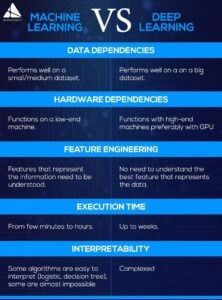Machine Learning and deep learning have gained a lot of popularity in recent years. Both are the subsets of artificial intelligence. Often, both the terms have been seen using interchangeably but both have a lot of differences. Examples of machine learning and deep learning are all around. It’s how Netflix understands which show you’re going to watch next, how Facebook recognizes whose face is in a picture, what makes self-driving cars a reality and a lot more.
So, let us start with the basic enlightenment of both the terms
So, AI is an all-encompassing term that originally erupted, followed by ML that thrived later, and finally, DL that is promising to scale AI’s progress to another level.
Machine learning is the best tool to analyze, comprehend and recognize data patterns so far. The main idea behind ML is that a computer is trained in a way to automate duties that are exhausting or complex to humans. It takes decisions with minimal human interference. Machine learning incorporates data to deliver an algorithm which can comprehend the connection between input and output. When the machine has fulfilled the learning, the value or class of the new data point can be predicted.
On the other hand, deep learning uses different layers to learn from data. It is also often called machine learning as it copies the network of neurons in a brain. The learning phase in deep learning is completed through a neural network which is an architecture in which layers are piled on top of each other.
Since you have understood the basic definition of machine learning and deep learning, let us now dig deep into the differences between both of them.

We will start off with the major difference between the two algorithms which is the ‘performance’. Deep learning algorithms require a huge amount of data to understand completely hence if the data is small DL algorithms do not work rightly. While in machine learning their handcrafted rules prevail in this setting.
Among both the algorithms, deep learning severely depends on high-end machines as compared to traditional machine learning which can swiftly work on low-end machines. Consequently, deep learning requirement comprises GPUs which is a fundamental part of its working. Comparatively, Deep learning algorithms do a large amount of matrix multiplication operations. All of these operations can be proficiently optimized by means of a GPU because it is made for this purpose.
Feature Engineering is a method of placing domain knowledge into the development of feature extractors to lessen data complexity and make patterns more visible for learning algorithms to function. This method is tricky and costly in terms of time and expertise. In machine learning, most of the characteristics used need to be recognized by the specialist and then hand-coded as per domain and data type. While deep learning algorithms try to learn high-level features from data. This is a very unique component of deep learning and a significant step forward in traditional machine learning. Deep learning thus minimizes the task of developing a new feature extractor for every problem.
The traditional machine learning algorithm is generally needed to break a problem into different parts to solve them individually and combine them to get the result. In contrast, deep learning backs to solve the problem end-to-end, such as logistic issues. Let’s further explain it with an example.
You are asked to detect multiple objects. In this task, we need to specify what the object is and where it is present in the picture. So, in the machine learning algorithm, this problem gets to divide into object detection and object recognition. First of all, we use the grabcut algorithm to skim through the picture and discover all possible items. Then, of all recognized objects, you would use an object recognition algorithm such as SVM with HOG to identify applicable objects. On the contrary, deep learning algorithm would perform the whole process end-to-end.
Deep Learning usually requires more time to train compared to machine learning. Because of the fact that there are so many parameters in a deep learning algorithm. On the other side, machine learning requires a lot less time to train, from a few seconds to a few hours.
But if we talk about testing time, the turn is completely opposite. The deep learning algorithm requires a lot less time to operate. Whereas, if you compare it with the nearest neighbors (a type of machine learning algorithm), the test time improves by increasing the size of the data.
Interpretability is the main factor deep learning is still thought 10 times before its use in industry. For instance, an automated marking of a test is done. The scoring done is accurate and quite human-like. But it does not explain why such marks or score were given. You can find out later which nodes of the neural network were activated, but we don’t understand what the neurons were intended to model and what these layers of neurons were doing together anyway. So, we fail to interpret the results.
While in machine learning algorithms such as decision trees offer us all the details we look for as to why it chose what has been marked. so, it is particularly simple to interpret the reasoning behind them. Therefore, algorithms such as decision trees and linear/logistic regression are mainly used for interpretability in the industry.